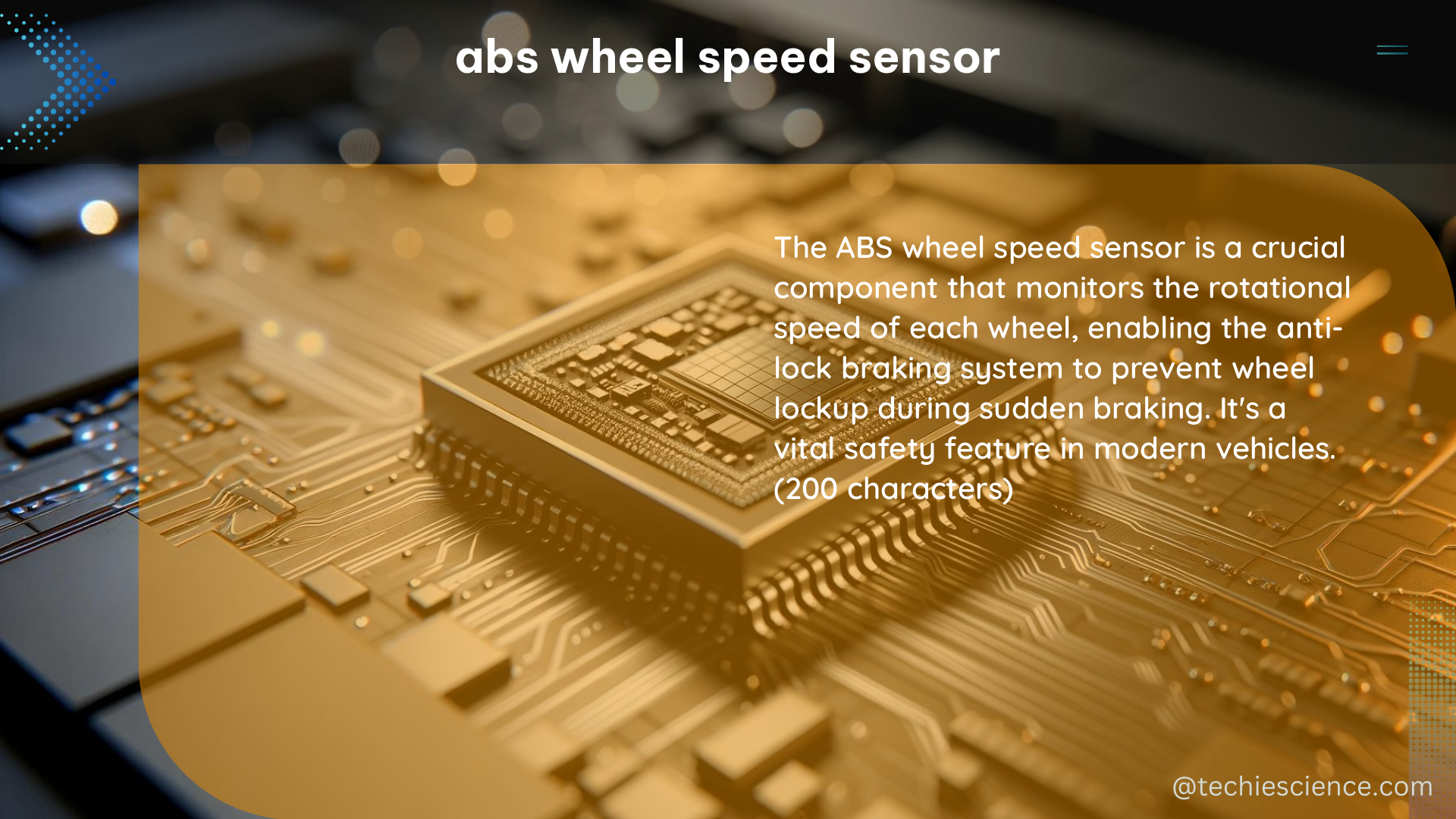The ABS (Anti-lock Braking System) wheel speed sensor is a critical component in modern vehicles, responsible for monitoring the rotational speed of each wheel and providing this data to the vehicle’s electronic control unit (ECU). This information is essential for the proper functioning of the ABS, which helps prevent wheel lockup during emergency braking, improving vehicle stability and control.
Understanding the Basics of ABS Wheel Speed Sensors
ABS wheel speed sensors can be classified into two main types: active and passive. Active sensors are powered by the ABS control unit and generate an output signal, while passive sensors operate without an external power supply, relying on the changes in magnetic flux to produce a signal.
Active ABS Wheel Speed Sensors
Active sensors are typically Hall effect or magnetoresistive sensors, which generate a digital signal proportional to the wheel’s rotational speed. These sensors require a constant supply voltage from the ABS control unit, typically ranging from 8 to 16 volts. The output signal frequency is directly related to the wheel speed, with a higher frequency indicating a faster rotation.
Technical Specifications of Active ABS Wheel Speed Sensors
- Supply Voltage: 8 to 16 VDC
- Output Signal: Digital, square wave
- Frequency Range: 0.5 Hz to 10 kHz, depending on wheel speed
- Signal Amplitude: 0.2 to 24 V, depending on sensor type and wheel speed
- Operating Temperature Range: -40°C to 125°C (-40°F to 257°F)
Passive ABS Wheel Speed Sensors
Passive sensors, such as inductive-passive sensors, generate an alternating voltage (AC) signal as the wheel rotates. This signal is induced by the changing magnetic flux caused by the rotation of the impulse ring (also known as the tone ring or encoder ring) attached to the wheel hub or brake disc.
Technical Specifications of Passive ABS Wheel Speed Sensors
- Signal Generation: Inductive, no external power supply required
- Output Signal: AC, sinusoidal
- Frequency Range: 0.5 Hz to 10 kHz, depending on wheel speed
- Signal Amplitude: 0.2 to 12 V, depending on sensor type and wheel speed
- Operating Temperature Range: -40°C to 125°C (-40°F to 257°F)
The Impulse Ring and its Role in ABS Wheel Speed Sensing

The impulse ring, also known as the tone ring or encoder ring, is a critical component in the ABS wheel speed sensing system. This ring is typically made of ferromagnetic material and is attached to the wheel hub or brake disc, rotating with the wheel.
The impulse ring features a series of evenly spaced teeth or slots, which create a changing magnetic field as the wheel rotates. The ABS wheel speed sensor is positioned in close proximity to the impulse ring, allowing it to detect the changes in the magnetic field and generate the corresponding signal.
Impulse Ring Specifications
- Material: Ferromagnetic (e.g., steel, iron)
- Number of Teeth/Slots: Typically 40 to 100, depending on vehicle and application
- Tooth/Slot Width: Approximately 1-3 mm
- Tooth/Slot Spacing: Evenly distributed around the ring
- Outer Diameter: Varies based on wheel size and vehicle application, typically 50-150 mm
- Mounting: Pressed into wheel hub or integrated into brake disc
ABS Wheel Speed Sensor Installation and Troubleshooting
Proper installation of the ABS wheel speed sensor is crucial for the correct functioning of the anti-lock braking system. Incorrect installation can lead to sensor damage, bearing wear, and even ABS system malfunctions.
Installation Considerations
- Sensor Positioning: The sensor must be positioned with a specific air gap (typically 0.5-1.5 mm) from the impulse ring to ensure reliable signal detection.
- Sensor Alignment: The sensor must be aligned with the center of the impulse ring teeth or slots to prevent signal interference or loss.
- Sensor Mounting: The sensor must be securely mounted to the vehicle’s suspension or brake assembly to prevent vibration and ensure consistent signal transmission.
- Wiring Harness: The sensor’s wiring harness must be routed and secured properly to avoid damage and interference with other vehicle components.
Troubleshooting Common ABS Wheel Speed Sensor Issues
- Sensor Failure: Symptoms may include illumination of the ABS warning light, inconsistent or erratic wheel speed readings, or complete loss of ABS functionality. Causes can include sensor wear, damage, or electrical issues.
- Impulse Ring Damage: Damage to the impulse ring, such as missing or deformed teeth, can lead to inaccurate wheel speed readings and ABS system malfunctions.
- Sensor Misalignment: Improper sensor positioning or alignment can result in intermittent or erratic wheel speed signals, causing the ABS system to function incorrectly.
- Wiring Harness Issues: Damaged, corroded, or improperly connected wiring can disrupt the sensor’s signal transmission, leading to ABS system failures.
To diagnose and resolve these issues, it is essential to follow the vehicle manufacturer’s recommended procedures, which may include visual inspections, electrical tests, and the use of diagnostic tools to measure sensor output and verify system operation.
Conclusion
The ABS wheel speed sensor is a critical component in modern vehicle braking systems, playing a vital role in maintaining vehicle stability and control during emergency braking situations. Understanding the technical specifications, installation requirements, and troubleshooting procedures for these sensors is essential for ensuring the proper functioning of the ABS system and the overall safety of the vehicle.
References:
- BRAKE DISCS AND WHEEL SPEED SENSORS IN ABS SYSTEMS, HELLA PAGID GMBH, 2022. https://www.hella-pagid.com/hellapagid/assets/media/Brake_Disc_ABS_PAGID_EN.pdf
- Check and change ABS and wheel speed sensors, HELLA GMBH & CO. KGaA, 2022. https://www.hella.com/techworld/us/Technical/Sensors-and-actuators/Check-change-ABS-sensor-4074/
- ABS wheel speed sensor, Explain that Stuff, 2022. https://www.explainthatstuff.com/abs.html

The lambdageeks.com Core SME Team is a group of experienced subject matter experts from diverse scientific and technical fields including Physics, Chemistry, Technology,Electronics & Electrical Engineering, Automotive, Mechanical Engineering. Our team collaborates to create high-quality, well-researched articles on a wide range of science and technology topics for the lambdageeks.com website.
All Our Senior SME are having more than 7 Years of experience in the respective fields . They are either Working Industry Professionals or assocaited With different Universities. Refer Our Authors Page to get to know About our Core SMEs.